
Are you struggling to rank higher in search engine results and drive more targeted traffic to your website? What if I told you that the secret to climbing above the competition might just lie in how you organize your content? That’s right! In today’s digital landscape, SEO content siloing has emerged as a powerful strategy to unlock the true potential of your site. This underutilized technique helps search engines understand your content better, ultimately boosting your rankings like never before. So, buckle up as we dive headfirst into unraveling the mysteries of SEO content siloing and discover how this game-changing approach can transform your online presence.
SEO content siloing is the process of structuring your website’s content around specific keyword themes and grouping related topics into distinct sections or “silos.” This approach helps search engines better understand the context and relevance of your content, improving your chances of ranking higher in search results for relevant queries. Additionally, siloing can improve the user experience on your website by making it easier for visitors to find and navigate the information they’re looking for.
Understanding SEO Content Siloing
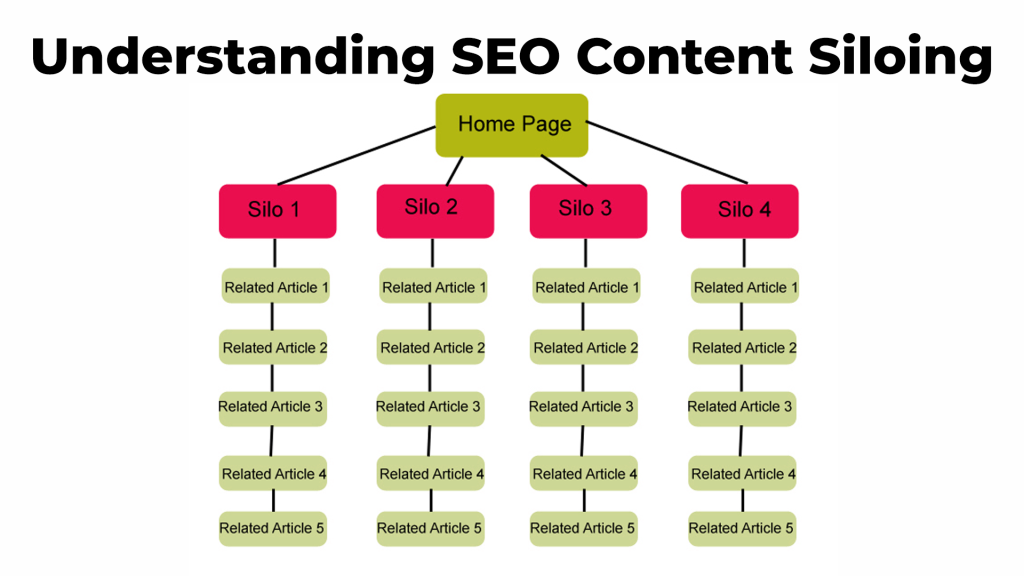
Understanding what SEO content siloing is, and why it matters, comes down to one key factor: organization. At its core, content siloing is the practice of grouping similar pages together on a website so that they have more relevance and context to search engines. This is achieved by linking these pages together with internal links, which sends signals to search engines about how the website should be understood.
By separating content into distinct sections, you can essentially create logical buckets of information. For example, let’s say you operate a website that sells shoes. By siloing your content on that site, you can group together pages that discuss topics like men’s dress shoes, women’s running shoes, and children’s sandals. This helps to signal to search engines that those pages are specifically about those topics.
To put it another way, think of a physical bookstore. If all of the books were tossed randomly on the shelves with no order or labels, it would be very hard for customers to find what they’re looking for. However, if the books are organized by genre or author name, the process becomes much easier. It’s the same with siloed content; without organization, search engines can’t effectively understand what a page or site is about.
Why does this matter? Because search engines want to provide their users with relevant results when they search for something online. By organizing content into logical buckets with clear themes and keywords, you’re making it easier for them to do that.
Another benefit of content siloing is that it can help boost your overall SEO efforts. When you create these internal links between pages and group them together based on a common theme or keyword, it strengthens the authority of those pages within your site. This increases their chances of ranking higher in search engine results pages (SERPs).
But perhaps even more importantly, content siloing can help to improve user experience on your site. When visitors come to your site, they’re looking for information that is relevant to their interests or needs. Siloed content makes it easier for them to find what they’re looking for quickly and efficiently.
Now that we’ve explored the concept of SEO content siloing and its importance, let’s dive into some of the specific advantages it can offer.
Advantages of Content Siloing
Enhanced Search Engine Performance
One of the primary advantages of content siloing is improved search engine performance. By grouping together related pages into logical silos, you’re essentially telling search engines what those pages are about. This helps them to understand your site better and improves the chances that your pages will rank higher in search results.
For example, let’s say you operate a website that sells office furniture. By creating distinct content silos for categories like office chairs, desks and filing cabinets, you’re sending clearer signals to search engines about what each page on your website is focused on. This makes it more likely that search engines will display those pages to people who are searching for those specific products.
User Experience Optimization
Another major benefit of content siloing is that it helps to optimize the overall user experience of your website visitors. By organizing content based on topic or theme, you’re making it easier for users to find what they’re looking for quickly and efficiently.
Let’s revisit our shoe store example from earlier. If a potential customer comes to your shoe store website looking specifically for women’s sandals, they’ll be able to navigate directly to that section because it’s part of a distinct content silo. This makes browsing much more efficient and user-friendly than if all of your shoe products were displayed randomly without any clear organization or categorization.
It’s worth noting that content siloing can also help to reduce bounce rates (i.e. the rate at which people leave your site after only viewing one page). When users are able to easily navigate and find what they’re looking for, they’re more likely to stay on your site for longer periods of time. However, it’s important to note that siloing should not be taken too far – there still needs to be some level of internal linking between silos in order for users to easily move between different sections of your site.
Content silos offer a wide variety of benefits, from improved search engine performance to better user experience optimization. In the next section, we’ll explore how you can structure content silos on your website to get the most out of them.
Enhanced Search Engine Performance
Search engine optimization is one of the most important aspects of digital marketing. Properly optimized content helps websites to rank higher in the search engines and boost their visibility to potential customers. Siloing content can enhance search engine performance by organizing a website’s content into distinct topics that are more easily understood by search engine crawlers.
For instance, let’s say you run a home decor store and focus on selling various kinds of home decor items like furniture, lightings, wall art etc. Now, it wouldn’t be ideal for your homepage to have all types of products on display – this would confuse both the search engine algorithms and the user. If you siloed your content by creating separate pages for each type of product (i.e., bedroom furniture, kitchen lighting fixtures), this would help the search engines understand what your website is about and how to appropriately rank it for relevant search queries.
By grouping related content into silos, you can create a strong topical relevance for your website. This, in turn, can help improve your website’s rankings and attract valuable organic traffic. Siloed sites usually experience less competition within themselves while competing effectively with other websites that focus on similar topics.
However, some people believe that siloing limits possible interlink opportunities amongst pages that may be beneficial for users searching for information across different silos. Though it may restrict linking from one silo to another, interconnected silos have similar contextual themes which remain useful.
Nevertheless, when used correctly, siloing does have advantages – one of its primary benefits being enhanced search engine performance.
- In digital marketing, search engine optimization is critical for enhancing website visibility and attracting potential customers. Siloing content by creating distinct topical clusters can help search engines better understand a website’s content, leading to improved rankings and attracting valuable organic traffic. Although siloing restricts linking between pages of different clusters, interconnected silos with similar contextual themes remain useful. Overall, when used correctly, siloing can enhance search engine performance and boost a website’s ranking.
User Experience Optimization
User experience is an integral part of digital marketing success as it ensures visitors stay on a website long enough to convert into paying customers. Optimizing user experience with siloed content involves creating a more logical organization of website content that is easier to navigate, which often leads to visitors staying longer on your site.
Using the home decor store example again – if you silo your content, it makes it easier for users to move from one section of your site to another. It helps them find exactly what they are looking for faster and provides them with a favorable user experience. This, in turn, impacts overall engagement metrics such as time on site and bounce rates positively.
As website usability improves due to organized silos, visitor satisfaction also increases. A well-designed and organized website enhances not only the stickiness of the page but also leads to an increase in customer loyalty and repeat visits. Ultimately, a visitor exposed to comprehensive information easily navigates through it and has higher chances of converting into a paying customer.
However, it’s important not to get so bogged down in siloing that you forget about cross-linking between different topics. Linking between silos helps users navigate between pages, discover new topics related to their interests – which encourages them back later on the site.
It’s like constructing a shopping mall- just like different shops arranged into categories within the massive structure make for smoother navigation; similarly, siloed content is compartmentalized into well-defined sections with logical sub-sections that can have links connecting them without losing context.
Content Silo Architectures
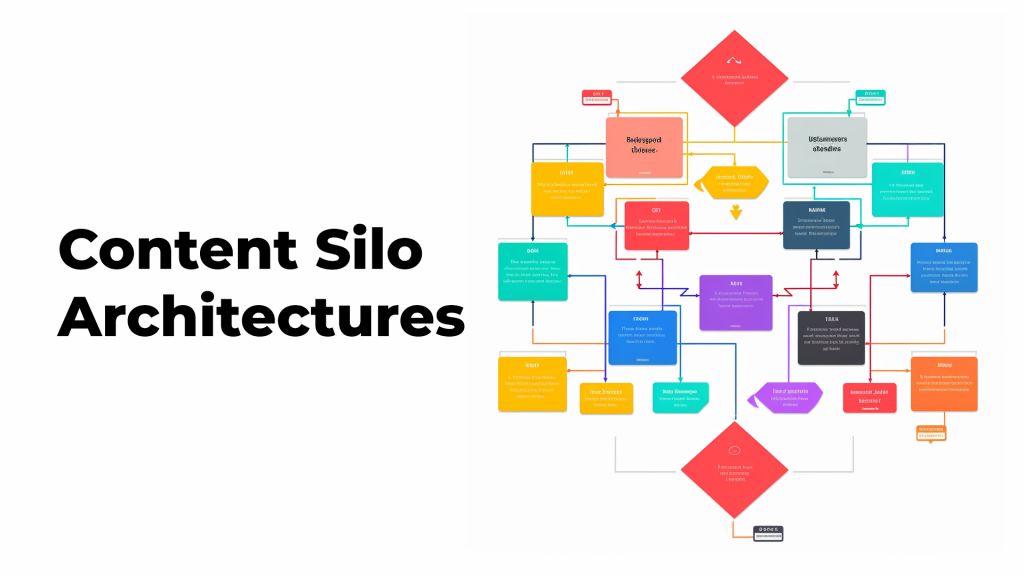
Content silos are a crucial component of a website’s SEO strategy. Properly structured content architecture can greatly improve a website’s search engine ranking and overall user experience. Implementing the right content siloing architecture can be complex, but it is worth exploring.
The idea behind content silo architecture is to create a specific structure for website content that groups together relevant information under broader topics. One can think of it as creating a hierarchy of topics that make sense to both users and search engines.
For instance, let’s consider an e-commerce website selling sports equipment. Their content silos would revolve around different categories such as basketball, soccer, tennis, or volleyball. Within each category, there would be different subcategories such as ‘basketball shoes,’ ‘basketballs’, ‘team jerseys’ etc.
Content architecture helps organize your website in a way that makes sense both to users and search engines. By grouping your content into common themes or topics, you signal to Google what specific areas you cover on your site. This organization helps search engines crawl your site more efficiently while simultaneously informing the user on what type of content they should expect from the different pages.
A well-structured website with properly functioning silos provides value to its visitors by facilitating easier navigation through the website’s many pages.
When it comes to designing content silos, there isn’t one-size-fits-all solution. It depends on different factors such as the type of business and audience. Mastering this process means understanding those factors and tailoring your archetypes to fit them effectively.
Another important factor is deciding how deep each silo should go. Some businesses prefer shorter silos, allowing visitors access to more information quicker. In contrast, others might opt for longer silos where visitors can explore deeper levels of detail in categories they are interested in.
Now that we have an understanding of content siloing, let’s dive into how to structure the individual silos themselves.
Focus on Keywords and Themes
Keywords and themes are the building blocks for content silos. They represent the target topics around which you build your content strategy. Using keyword research tools like Google Keyword Planner or Moz Keyword Explorer, businesses can identify popular search terms within their industry.

Once you have identified your keywords, you can begin to develop content that is focused on them. Themes help organize your content effectively to appeal to both search engines and users. Your themes should comprise all relevant information about a specific topic so visitors have all the knowledge they need to make an informed decision on your site.
For instance, suppose your e-commerce website deals with sports equipment. In that case, the term ‘basketball shoes’ could be a theme around which you construct your silo. You would then add supporting subtopics such as ‘popular brands,’ ‘shoe design,’ ‘performance features,’ and so on to complete the theme.
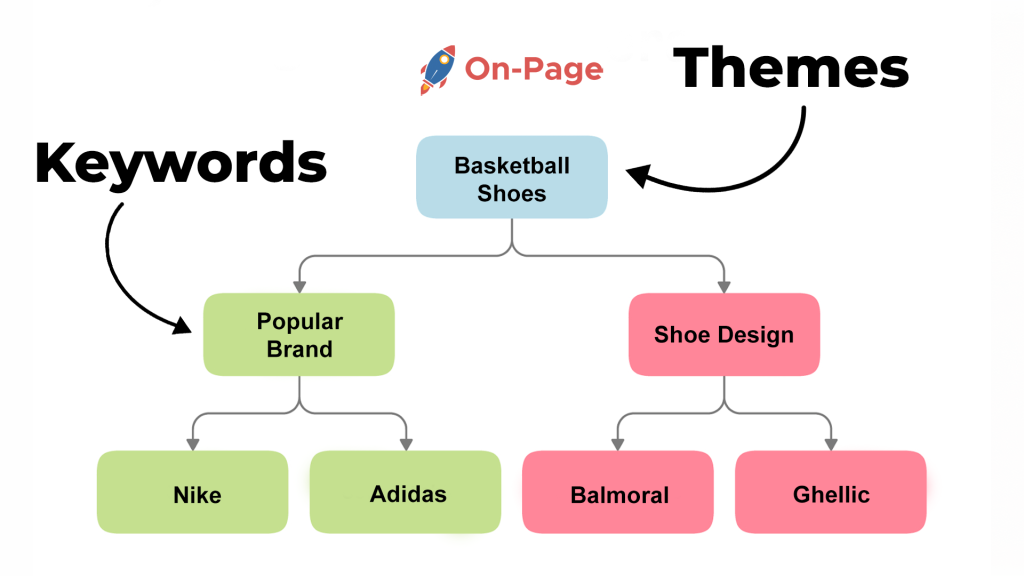
By creating well-developed themes and organizing them through silos, websites can boost their relevance by telling search engines precisely what kind of topics they cover. Thus it increases the chances of appearing higher up on search results pages.
Moreover, organizing themes within silos allows visitors access to all relevant information easily and quickly. It provides a logical path for users through the website’s pages with organized information like articles, videos or product pages etc.
While it is essential to develop content based on keyword research, one shouldn’t forget about user experience. Overdoing keyword stuffing could negatively affect user engagement by presenting poorly written content damaging the overall brand image.
Therefore businesses should focus on developing high-quality content that satisfies user intent while incorporating relevant keywords properly within them without affecting its readability.
Now that we have thoroughly looked into structuring content silos and incorporating focused themes based on keyword research, the next step of our journey is to explore how integrating silos can help improve overall website performance.
Organizing Hierarchically
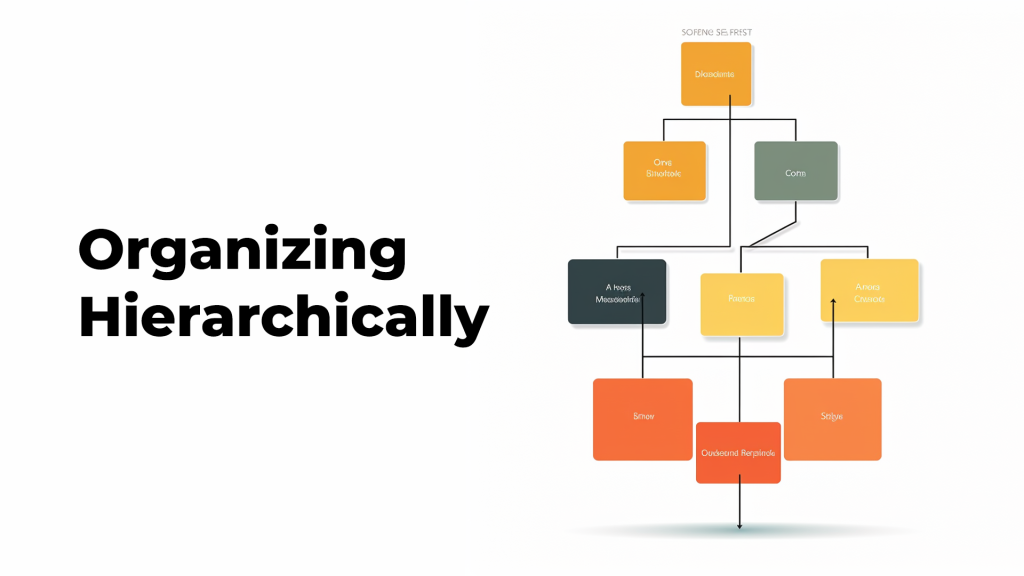
Organizing content hierarchically is a key component of SEO content siloing. In hierarchical organization, the most important content occupies the top of the pyramid, followed by similarly related content. The bottom tier contains less closely related topics. This method uses themes and ideas to categorize web pages and link them to ensure that all content focuses on a specific topic or theme.
For example, consider a website that focuses on sports and has separate sections for basketball, football, hockey, and golf. Each section will have several subcategories that cover specific aspects of each sport (such as players, rankings, schedules). The highest level in the hierarchy will be the “Sports” category under which all subcategories will be nested.
By using a hierarchical organization approach, website administrators can create an easy to follow structure that improves visitor experience and provides search engines with better context about page relevance for increased visibility. Pages are linked within their own category providing search engines with better relevance signals which leads to higher search engine rankings.
However, some experts believe that it is not necessary to go through the trouble of explicitly creating a hierarchical structure. They argue that doing so may make it difficult for search engines to find useful information across a site since they require internal linking between silos for information sharing.
Nevertheless, when properly implemented, a hierarchical organization can help with the creation of semantic landing pages where visitors can easily find valuable content about specific topics/themes.
Breaking Silos for Integration
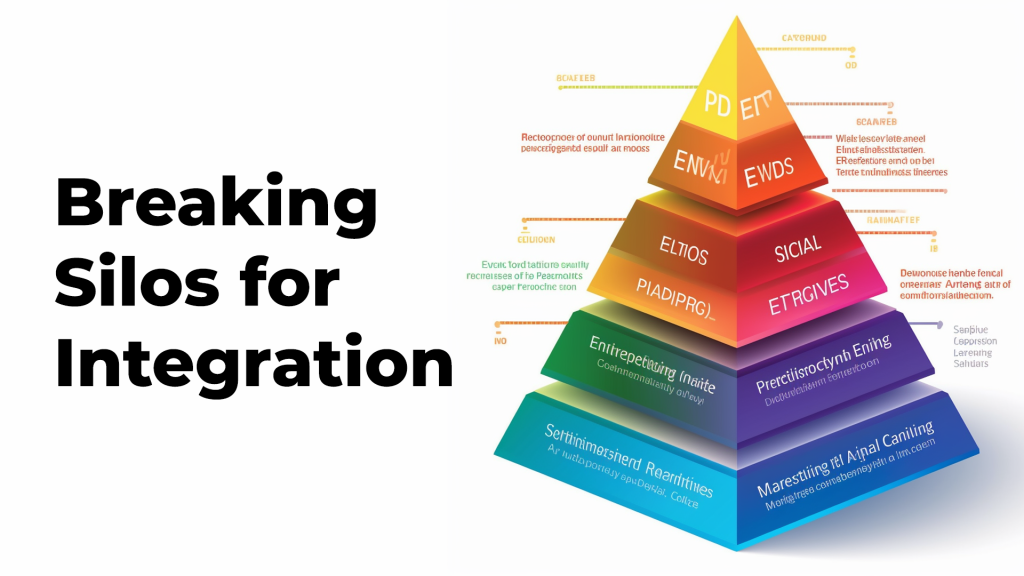
One way to break silos in SEO content siloing is by connecting related topics together. Connecting related topics can promote cross-linking between categories and boost user engagement with your website while still keeping everything organized hierarchically.
Imagine that you’re running a cooking blog divided into different categories: main dishes, desserts, appetizers, and drinks. Concretely, you write a recipe for a strawberry cake, which can belong in the dessert category. After researching more about strawberries, you realize there is enough material to build an entire section focusing only on strawberry recipes. By creating this additional content category, readers can quickly find all relevant information on your website without having to search hard for it.
Connecting related topics provides insight into user-generated keywords and their intent. By identifying these keywords you can potentially fill gaps in existing categories or create new ones that will help boost relevance signals for increased search engine visibility.
Breaking silos is like creating a treasure map where each X marks a spot of valuable information related to your main theme(s). With silos broken, visitors can easily navigate from one place to another on the treasure map without getting lost while search engines clearly understand important pages’ context providing better ranking in SERPs.
In conclusion integrating different content categories promotes cross-linking and boosts visitor engagement with your website while increasing search engine rankings by filling gaps in existing categories or creating new ones that best complement a site’s niche.
- A study conducted by Moz in 2018 found that websites with organized content and proper silo structure experienced a 6-12% increase in organic search traffic compared to websites with unorganized structures.
- According to a 2020 survey by Content Marketing Institute, 48% of digital marketers reported that implementing an effective content silo strategy significantly improved the visibility and ranking of their website on search engine results pages.
- Research by HubSpot in 2021 revealed that websites with a well-structured silo architecture had an average increase of 15% in user engagement metrics, such as time on site, page views per session, and reduced bounce rates.
Connecting Related Topics and Content
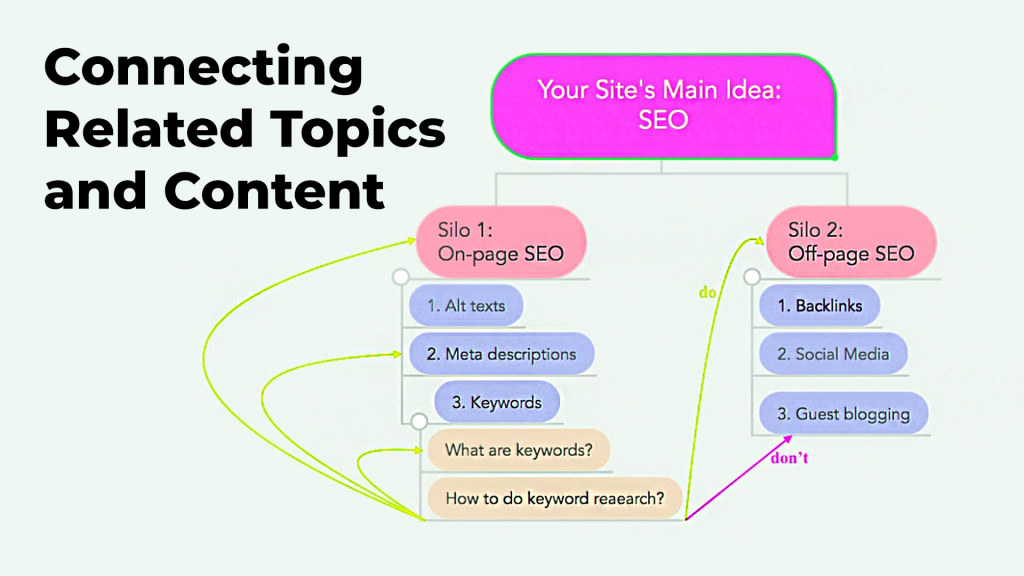
One of the key components of creating effective content silos is connecting related topics and content. Without proper interlinking, your content silos may become isolated and lose their effectiveness in improving search engine performance and user experience optimization.
Interlinking related topics within a content silo not only aids in navigation but also forms a relationship between these topics. It helps Google to understand the interconnectedness of various pieces of content, hence enhancing the relevancy of your website in search results. This results in better organic rankings and increased traffic from search engines.
For instance, if you run a website on healthy living, you may have several separate silos on different topics, such as exercise, diet plans, supplements, etc. Interlinking these topics through blog posts or pages can help Google understand that they are all part of a larger topic, ‘healthy living.’ With this knowledge, Google can better categorize your site’s pages in its index and show them for relevant searches.
Proper interlinking also plays an important role in encouraging users to explore deeper into your website content. Linking relevant pages or posts can lead visitors down a path towards more information about their interests or problems they are looking to solve. This can keep visitors engaged with your site longer and increase the likelihood that they will convert into customers or sales leads.
While linking related content together is crucial for building effective content silos, some proponents argue that it’s equally important not to overdo it by having too many internal links. Excessively linking pages together in a way that seems artificial or spammy can lead to penalties from search engines rather than rewards.
However, ensuring that links are valuable and contextually relevant can go a long way towards improving user experience on your site. Having an organized internal linking structure with well-thought-out connections between pages can indicate to search engines that your content is high quality and relevant.
Think of your content silos like roads on a map: each road leads to different destinations, but they all ultimately lead back to the same hub. Establishing connections between related topics is like building off-ramps and highways – it makes it easier for people (and search engines) to navigate and explore, leading them towards their desired destination.
To create effective content silos that connect related topics and drive traffic, consider using On-Page.ai. Its AI-powered technology offers advanced on-page optimization recommendations. On-Page.ai’s powerful Stealth Writer Tool can help you generate optimized content with the use of a keyword in just one click. It further provides an in-depth analysis of your website’s performance, enabling you to identify issues and potential improvements, including proper interlinking techniques. Try On-Page.ai today to start creating effective content silos.
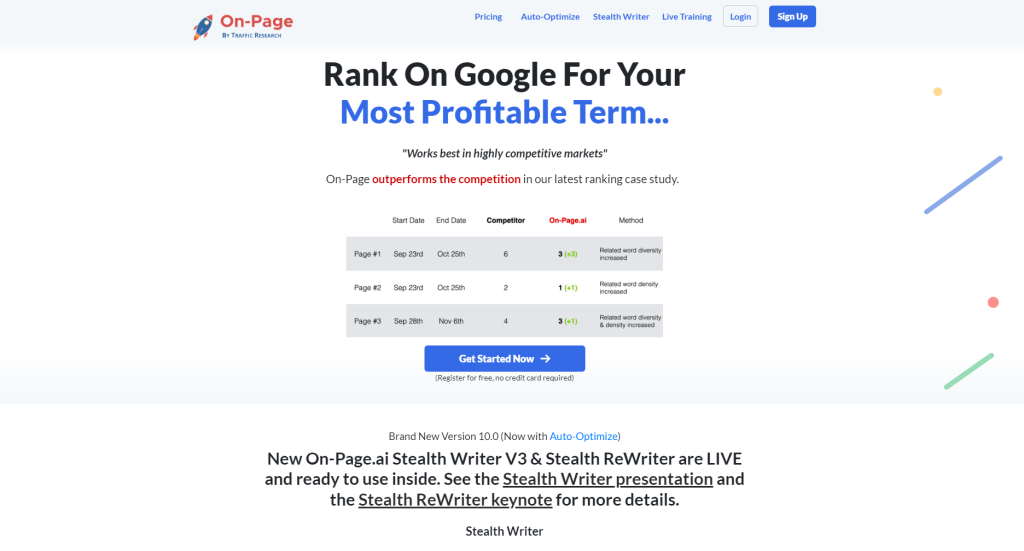
Common Questions Explained
Is content siloing necessary for all websites or only specific ones?
Content siloing is a powerful technique that can significantly improve your SEO performance. However, whether it’s necessary for your website or not depends on various factors.
If you have a large website with multiple topics, content siloing can help you organize your content into distinct categories or silos. By doing so, you signal to the search engines that each category is relevant and focused, which can lead to better rankings.
On the other hand, if you have a small website focusing on one particular topic, content siloing may not be as critical, but it is still helpful for making your site easier to navigate and understand for users and search engines.
Studies show that websites with clear information architecture tend to perform better in search engine results pages (SERPs). According to a study by Moz, sites with good information architecture had an average 2.3 times higher ranking than those without it.
In conclusion, while content siloing isn’t necessary for all websites, it is useful for building a more organized and structured website that is easier for both users and search engines to navigate.
How do you implement SEO content siloing on a website?
Implementing SEO content siloing on a website involves a strategic approach to organizing and linking content within the site. The first step is to identify the main topics or themes that your website covers and then create subtopics or categories that are closely related to those main topics.
Once these categories have been established, it is important to ensure that each piece of content on the site is properly optimized for the specific category it falls under. This includes using relevant keywords, titles, and meta descriptions that accurately reflect the topic of the content.
Internal linking is another crucial element in SEO content siloing. Linking between pages within the same category helps to establish a clear hierarchy and signals to search engines that your site is organized and authoritative on its respective topics.
According to a study by Moz, websites with strong internal linking structures tend to rank higher in search engine results pages (SERPs) than sites with weak internal link structures. This further emphasizes the importance of implementing SEO content siloing on a website.
In conclusion, implementing SEO content siloing involves identifying main and subtopics, optimizing each piece of content for its respective category, and creating a strong internal linking structure within each category. Doing so can lead to improved search engine rankings and increased visibility for your website.
How does SEO content siloing help with website optimization?
SEO content siloing is a powerful strategy that can help any website improve its optimization efforts. By grouping related pages on your website into targeted categories, or “silos,” you can help search engines understand the themes and topics that your website covers, which in turn increases your rankings and visibility.
One key benefit of SEO content siloing is improved internal linking. When similar content is grouped together within a silo, it becomes easier to create internal links between related pages. This helps website visitors easily navigate through the site and also helps search engines better understand the hierarchy and organization of your site’s content.
Another advantage of SEO content siloing is increased relevance to keyword search phrases. By grouping related topics into thematic silos, you can naturally create clusters of keywords and search terms that make your site more relevant to specific user searches and queries. In fact, research has shown that websites with well-structured silos have higher rankings for targeted search phrases than those without.
Overall, incorporating SEO content siloing into your website optimization plan can be a highly effective way to improve your website’s visibility, authority, and user experience. By organizing your content around key themes and topics, you can increase internal linking and relevancy to target keywords, helping you rank higher in search engine results pages (SERPs) and ultimately drive more organic traffic to your site.
What are the different types of content silos used in SEO?
When it comes to SEO content siloing, there are several types of silos that can be used to effectively organize and structure your website’s content for improved search engine ranking. Here are some of the most common types of content silos and how they work:
1. Topical Content Silos: This type of content silo strategy is organized around broad topical categories. It works best when your site has a diverse range of content that can be classified into different topic areas. According to a recent study by SEMrush, websites with topical content silos saw an average increase in organic traffic of 49%.
2. Geographic Content Silos: These silos are organized around specific geographic regions or locations. They work well if you have a local business or if geographic location is important to your target audience. A study by BrightLocal found that having consistent location data across all digital platforms can improve local SEO and help businesses appear higher in search results.
3. Product/Service Content Silos: As the name suggests, this type of silo strategy organizes your website’s content around specific products or services offered by your business. This can help streamline the user experience for visitors looking for information on specific offerings, making it easier for them to find what they need. A study by Search Engine Journal found that product page optimization is key for e-commerce sites looking to maximize their search engine visibility.
Overall, implementing content silos as part of your SEO strategy can have a positive impact on your website’s search engine ranking and traffic. So, whether you’re using topical, geographic, or product/service silos (or a combination thereof), taking the time to organize your content in a strategic way can pay off in the long run.
What are the common mistakes to avoid when implementing SEO content siloing?
When it comes to SEO content siloing, there are some common mistakes that should be avoided at all costs. One of the most significant mistakes is failing to plan your website structure before creating content. This mistake often leads to a confusing and unorganized website structure that confuses both search engines and users. According to a study by Kissmetrics, 39% of visitors will stop engaging with a website if images don’t load or if the website takes too long to load.
Another mistake that’s frequently made is creating too many subcategories within a silo. While it may seem like a good idea to create as many subcategories as possible, this can lead to over-categorization, which makes it challenging for search engines and users to navigate. According to HubSpot, websites with more than seven categories on their navigation menu have an average bounce rate of 25%, compared to those with fewer categories, which have an average bounce rate of 13%.
Lastly, not linking silos together or failing to use appropriate anchor text can significantly impact your website’s visibility. When implementing SEO content siloing, it’s crucial to link related pages within the same silo using relevant anchor text. Failure to do so can result in search engines being unable to crawl and index your content correctly. A study by Moz revealed that websites with more internal links tend to rank higher on search engine results pages.
In conclusion, avoid these common mistakes when implementing SEO content siloing can have significant negative impacts on your website’s visibility and ultimately affect your bottom line as well. Planning your website structure before creating content, limiting subcategories within each silo, and linking related pages using relevant anchor text are key ingredients in unlocking the power of SEO content siloing.
Let On-Page.ai SEO optimization tool help you implement effective SEO content siloing for your website. Sign up today to get started!




